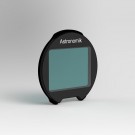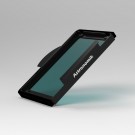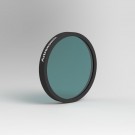- Astronomik Lunar calendar for 2024
The Astronomik calendar of the Lunar phases in 2024 is ready.
- Chistmastime and New Year 2023-2024
We wish you a merry Chirstmastime and a happy and healthy 2024...
- Astronomik Lunar calendar for 2023
The Astronomik calendar of the Lunar phases in 2023 is ready.
- Chistmastime and New Year 2022-2023
We wish you a merry Chirstmastime and a happy and healthy 2023...
- Shipping methods
Shipping as registred good shipment is no longer available
- How to observe planetary nebulae
A very nice introduction to observing planetary nebulas written by Owen Brazell
The Astronomik UHC is THE filter for visual observing.
You will enjoy using your Astronomik UHC filter because you will see more stars and more details in deep-sky-objects compared to using filters from all other manufacturers.
The Astronomik UHC (Ultra High Contrast) filter allows the transmission of nearly 100% of the radiation from both O-III and the H beta lines. Though the second window for the H-alpha-line is not intended for visual observing, it is important, if the filter is used with an electronic device. All annoying, scattered light from other wavelength sources, including local artificial light pollution, is reliably filtered out. With this strong blocking of the sky background an unexpected wealth of detail becomes visible for gas nebulae and planetary nebulae.
Main use
Astronomik UHC filters’ astounding high light transmission brings better views of deep-sky-objects even to small telescopes! The high transmission of our optical glass filters means that enough light is available to allow successful visual observations with telescopes beginning at 2" (50mm) aperture. Our Astronomik filters are optimized for use with telescope focal length f / ratios of f/4 to f/15. Transmission losses and chromatic distortions, which arise with other filters, only occur with Astronomik filters when extremely bright aperture ratios of 1:2 and more come into play. Another major advantage of our Astronomik UHC filter is the high optical quality of the filter glass. When using Astronomik UHC filters you will quickly notice the same needle-sharp stars which you are familiar with from your astronomical instrument without any filter!
more information about the visual Astronomik filters
How to read the chart
The major emission lines of artifical light pollution:
| Hg 435,8nm | Hg 546,1nm | Hg 577,0nm | Hg 578,1nm |
| Na 589,0nm | Na 589,6nm | Na 615,4nm | Na 616,1nm |
The major emission lines of nebulas:
H-β 486,1nm | OIII 495,9nm | OIII 500,7nm | H-α 656,3nm
- The horizontal axis is the Wavelength in Nanometers (nm). 400nm is deep blue, at 520nm the human eye senses green and at 600nm red. At 656nm is the famous "H-Alpha" emission line of hydrogen.
- The transmission in % is plotted on the vertical axis.
- The red line shows the transmission of the filter.
- Visual filters: The grey line in the background shows the relative sensitivity of the human eye at night. The maximum is at ~510nm and drops to longer and shorter wavelengths. You can easily see, that you can´t see anything of the H-alpha line at night (even if you can during daylight!) The sensitivity at 656nm is 0% at night!
- Photographic filters: The grey line in the background shows the sensitivity of a typical CCD sensor.
- The most important artifical emission lines are shown in orange. The artifical light pollution is dominated by see mercury (Hg) and sodium (Na), which are used in nearly all streetlights.
- The most important emission lines from nebulas are shown in green. The most important lines are from ionized Hydrogen (H-alpha and H-beta) and double ionized oyxgen (OIII).
The major emission lines of artifical light pollution:
| Hg 435,8nm | Hg 546,1nm | Hg 577,0nm | Hg 578,1nm |
| Na 589,0nm | Na 589,6nm | Na 615,4nm | Na 616,1nm |
The major emission lines of nebulas:
H-β 486,1nm | OIII 495,9nm | OIII 500,7nm | H-α 656,3nm
Suitability
- Visual observation (dark skies): Very good, for telescopes of all apertures and high exit pupil
- Visual observation (urban skies): Very good, for telescops from 100 mm aperture
- Film photography: Reasonable, but very long exposure time
- CCD photography: Good, when used with an additional IR-block-filter
- DSLR photography (original): Good, colour balance shifted but contrast enhanced
- DSLR photography (astro modified): Very good, colour balance is near perfect
- DSLR photography (MC modified): Good, when used with an additional IR-block-filter
- Webcam / Video (Planets): Unsuitable
- Webcam / Video (Deep Sky): Good, if light pollution is a big problem
Technical Data
- typ. 95% transmission at 486nm (H-beta)
- typ. 95% transmission at 496nm (OIII)
- typ. 95% transmission at 501nm (OIII)
- typ. 95% transmission at 656nm (H alpha)
- optimum position of transmission for telescopes with focal ratios from f/10 to f/3,5
- Entire Blocking of annoying wavelengths
- Ideal All-round Deep Sky filter even for small telescopes
- Not sensitive to humidity or aging
- Scratch-resistant!
- Excellent carrier material. The optical performance of your telescope is not reduced by the filter in any way.
- Parfocal with other Astronomik filters
- Glass thickness: 1mm
- Completely resistant against high humidity, scratches and aging effects
- Diffraction limited, the filter will not reduce the optical performance of your telescope!
- Astronomik filters are delivered in a high-quality, long lasting, filter box
The filter is available in the following sizes
Filter displayed products below by their features
- Size
-
- 1,25" (M28,5) (1)
- 2" (M48) (1)
- T-thread cell (M42x0,75) (1)
- SC-cell (2" / 24TPI) (1)
- Ø31mm (1)
- Ø36mm (1)
- Ø50mm (1)
- 50x50mm, ungefasst (1)
- EOS APS-C Clip-Filter (1)
- EOS M Clip-Filter (1)
- EOS XL Clip-Filter (1)
- Sony alpha Clip-Filter (1)
- Nikon XL Clip-Filter (1)
- Pentax K Clip-Filter (1)
- M49 (1)
- M52 (1)
- type
-
- UHC (6)
UHC Filter
-

Astronomik UHC 1,25'' (M28,5)
excl. VAT (Non-EU): €83.19 incl. VAT (EU): €99.00 -

Astronomik UHC 2'' (M48)
excl. VAT (Non-EU): €167.23 incl. VAT (EU): €199.00 -

Astronomik UHC Clip-Filter EOS APS-C
excl. VAT (Non-EU): €116.81 incl. VAT (EU): €139.00
-

Astronomik UHC Clip-Filter EOS XL
excl. VAT (Non-EU): €184.03 incl. VAT (EU): €219.00 -

Astronomik UHC XT Clip-Filter EOS M
excl. VAT (Non-EU): €133.61 incl. VAT (EU): €159.00 -

Astronomik UHC Clip-Filter Sony alpha 7
excl. VAT (Non-EU): €200.84 incl. VAT (EU): €239.00
-

Astronomik UHC Clip-Filter Nikon XL
excl. VAT (Non-EU): €200.84 incl. VAT (EU): €239.00 -

Astronomik UHC Clip-Filter Pentax K-1
excl. VAT (Non-EU): €200.84 incl. VAT (EU): €239.00 -

Astronomik UHC T-Mount (M42x0,75)
excl. VAT (Non-EU): €150.42 incl. VAT (EU): €179.00
-

Astronomik UHC SC Rear Cell (2'' / 24TPI)
excl. VAT (Non-EU): €192.44 incl. VAT (EU): €229.00 -

Astronomik UHC 31mm
excl. VAT (Non-EU): €100.00 incl. VAT (EU): €119.00 -

Astronomik UHC 36mm
excl. VAT (Non-EU): €116.81 incl. VAT (EU): €139.00
-

Astronomik UHC 50mm
excl. VAT (Non-EU): €175.63 incl. VAT (EU): €209.00 -

Astronomik UHC M49
excl. VAT (Non-EU): €192.44 incl. VAT (EU): €229.00 -

Astronomik UHC M52
excl. VAT (Non-EU): €192.44 incl. VAT (EU): €229.00

 Deutsch
Deutsch English
English




